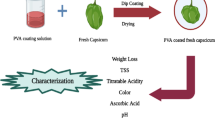Abstract
The objective of this study was to determine vitamin C stability in fresh and freeze-dried capsicum during storage at different temperatures. Fresh capsicum stored at 20 °C showed an initial decrease in vitamin C with a minimum peak after 2 days and then increased to a maximum peak after 13 days followed by a gradual decay. In general a gradual decrease of vitamin C was observed in the cases of fresh (i.e. stored at 5, −20, −40 °C) and freeze-dried capsicum stored at all temperatures (i.e. 60 to −40 °C). The degradation kinetics of vitamin C was modeled by zero and first order reaction and rate constants were estimated. The rate constant increased with the increase in storage temperature, while it was decreased with the decrease of moisture content. At storage temperature 5 °C, first order rate constants were observed as 7.1 × 10−2, 7.7 × 10−2, and 4.3 × 10−3 day−1 in the cases of samples containing moisture contents 94, 15 and 5 g/100 g sample, respectively.




Similar content being viewed by others
References
AOAC (1990) In: Helrich K (ed) Association of official analytical chemists. Official methods of analysis of the AOAC. AOAC, Arlington
Ariahu CC, Abashi DK, Chinma CE (2011) Kinetics of ascorbic acid loss during hot water blanching of fluted pumpkin (Telfairia occidentalis) leaves. J Food Sci Technol 48(4):454–459
Blasco R, Esteve MJ, Frigola A, Rodrigo M (2004) Ascorbic acid degradation kinetics in mushrooms in a high-temperature short-time process controlled by a thermoresistometer. Food Sci Technol 37:171–175
Burdurlu HS, Koca N, Karadeniz F (2006) Degradation of vitamin C in citrus juice concentrates during storage. J Food Eng 74:211–216
Carnelossi MAG, de Sena HC, Narain N, Yaguiu P, da Silva GF (2009) Physico-chemical quality changes in Mangaba (Hancornia speciosa gomes) fruit stored at different temperatures. Braz Arch Biol Technol 52(4):985–990
Gonzalez-Molina E, Girones-Vilaplana A, Mena P, Moreno DA, Garcia-Viguera C (2012) New beverages of lemon juice with elderberry and grape concentrates as a source of bioactive compounds. J Food Sci 77(6):C728–C733
Goula AM, Adamopoulos KG (2006) Retention of ascorbic acid during drying of tomato halves and tomato pulp. Drying Technol 24:57–64
Gupta MK, Sengal VK, Arora S (2013) Optimization of drying process parameters for cauliflower drying. J Food Sci Technol 50(1):62–69
Hiatt AN, Taylor LS, Mauer LJ (2010) Influence of simultaneous variations in temperature and relative humidity on chemical stability of two vitamin C forms and implications for shelf life models. J Agric Food Chem 58:3532–3540
Hossain MA, Gottschalk K (2009) Effect of moisture content, storage temperature and storage period on colour, ascorbic acid, lycopene and total flavonoids of dried tomato halves. Int J Food Sci Technol 44:1245–1253
Howard LA, Wong AD, Perry AK, Klein BP (1999) β-carotene and ascorbic acid retention in fresh and processed vegetables. J Food Sci 64(5):929–936
Johnston CS, Hale JC (2005) Oxidation of ascorbic acid in stored orange juice is associated with reduced plasma vitamin C concentrations and elevated lipid peroxides. J Am Diet Assoc 105:106–109
Kek SP, Chin NL, Yusof YA (2013) Simultaneous time-temperature thickness suspension theoretical and statistical modeling of convective drying of guava. J Food Sci Technol (in press)
Klimczak I, Maecka M, Szlachta M, Gliszczynska-Swigo A (2007) Effect of storage on the content of polyphenols, vitamin C and the antioxidant activity of orange juices. J Food Comp Anal 20:313–322
Lee SK, Kader AA (2000) Preharvest and postharvest factors influencing vitamin C content of horticultural crops. Postharvest Biol Technol 20:207–220
Lemmens L, Van Buggenhout S, Oey I, Van Loey A, Hendrickx M (2009) Towards a better understanding of the relationship between the beta-carotene in vitro bio-accessibility and pectin structural changes: a case study on carrots. Food Res Int 42(9):1323–1330
Leong SY, Oey I (2012) Effects of processing on anthocyanins, carotenoids and vitamin C in summer fruits and vegetables. Food Chem 133:1577–1587
Majumdar TK, Vasudish CR, Premavalli KS, Bawa AS (2009) Development and storage stability of cucumber-litchi-lemon juice. J Food Sci Technol 46(3):269–270
Marques LG, Silveira AM, Freire JT (2006) Freeze-drying characteristics of tropical fruits. Drying Technol 24:457–463
Marques LG, Ferreira MC, Freire JT (2007) Freeze-drying of acerola (Malpighia glabra L.). Chem Eng Process 46:451–457
Phillips KM, Tarrago-Trani MT, Gebhardt SE, Exler J, Patterson KY, Haytowitz DB, Pehrsson PR, Holden JM (2010) Stability of vitamin C in frozen raw fruit and vegetable homogenates. J Food Comp Anal 23:253–259
Sablani SS, Al-Belushi K, Al-Marhubi I, Al-Belushi R (2007) Evaluating stability of vitamin C in fortified formula using water activity and glass transition. Int J Food Prop 10:61–71
SAS (2002) The SAS system for windows, version 9. SAS Institute, Carry
Torregrosa F, Esteve MJ, Frigola A, Cortes C (2006) Ascorbic acid stability during refrigerated storage of orange–carrot juice treated by high pulsed electric field and comparison with pasteurized juice. J Food Eng 73:339–345
Vanderslice JT, Higgs DJ, Hayes JM, Block G (1990) Ascorbic acid and dehydroascorbic acid content of foods-as eaten. J Food Comp Anal 3:105–118
Verma M, Singh J, Kaur D, Mishra V, Rai GK (1993) Effects of various dehydration methods and storage on physicochemical properties of guava powder. J Food Sci Technol. doi:10.1007/s13197-013-1020-0
Wu Y, Perry AK, Klein BP (1992) Vitamin C and β-carotene in fresh and frozen green beans and broccoli in a simulated system. J Food Qual 15:87–96
Acknowledgments
The authors would like to acknowledge the support of Sultan Qaboos University towards their research in the area of food structure and its stability.
Author information
Authors and Affiliations
Corresponding author
Rights and permissions
About this article
Cite this article
Rahman, M.S., Al-Rizeiqi, M.H., Guizani, N. et al. Stability of vitamin C in fresh and freeze-dried capsicum stored at different temperatures. J Food Sci Technol 52, 1691–1697 (2015). https://doi.org/10.1007/s13197-013-1173-x
Revised:
Accepted:
Published:
Issue Date:
DOI: https://doi.org/10.1007/s13197-013-1173-x




